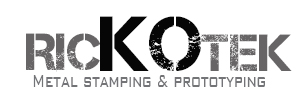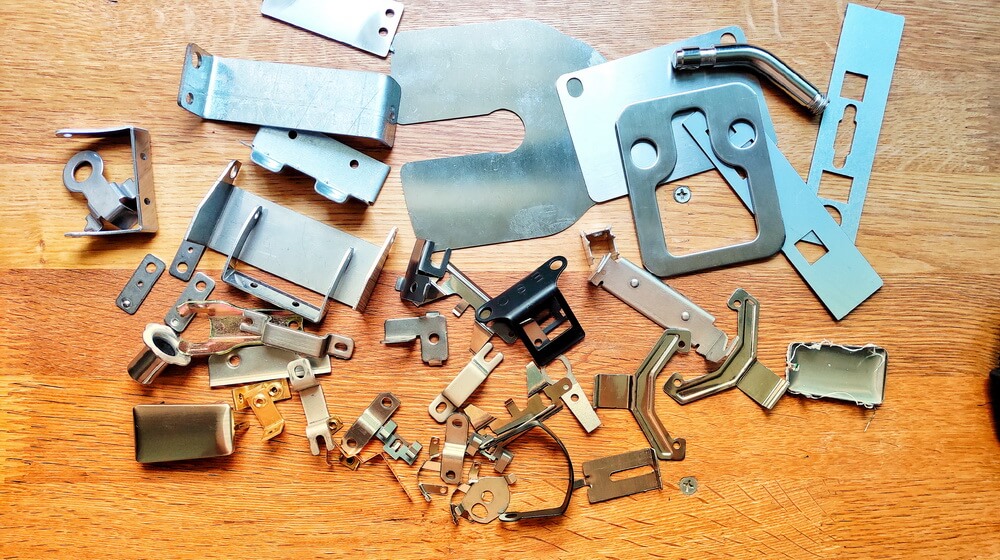The popularity of metal stamping parts has only grown over the decades since it was first introduced and for a good reason.
But what is precision metal stamping, what does it produce, and what are the limitations of the process?
What is Precision Metal Stamping?
A cold-forming process that uses stamping presses and dies to create different shapes of sheet metal, metal stamping manufacturers make use of this process to create different types of items.
A piece of sheet metal or blank is fed into a stamping press, and metal stamping transforms it into a new shape.
This precision metal stamping process can be altered through the use of different stamping parts, which are interchangeable on the stamping machine
The advantages of precision metal stamping are considerable, starting with the low cost of the process and the ability to create identical shapes from metal in rapid succession.
For example, if a metal part is needed, this stamping process can create them at a high rate of speed with considerable precision at a low cost.
Common Metals Used for Metal Stamping: What follows are some of the common metals used by metal stamping manufacturers.
- Ferrous & Non-Ferrous
- Aluminum & Aluminum Clad Copper
- Stainless Steel, Titanium, & Noble Metals
- Pre-plated, Mylar, and Wire
It is a wide range of metals that can be stamped, which is why the process itself is quite popular. However, before a type of metal is submitted to be used.
It must be evaluated by engineers to ensure that it is the right one. Otherwise, the metal might crack or be damaged in the process.
Stamping Operations
Several types of metal stamping operations may be used in the construction of metal parts. Knowing which type is best suited for the part you want to create will make it easier to produce in mass quantities.
Fine Blanking: Called fine-edge blanking, it creates smooth, accurate edges for parts.
It usually uses a mechanical or hydraulic press which clamps the material in place, performs a blanking operation, and ejects the finished part.
It uses high pressure and is relatively quick, which reduces the overall cost of creating a part.
Four-Slide: Sometimes called multi-slide, The metal stamping companies use four sliding tools to create complex parts and components.
Progressive: As the name suggests, it uses a series of stamping stations to punch out a part one section at a time.
Transfer: Similar to progressive, but instead uses a mechanical transport station or conveyer belt to feed the part into different stamping machines.
Most manufacturers also have different types of stamping presses, and stamping dies to create specific parts. However, despite all the variations of operations, stamping presses, and dies, there are still limitations to the process.
Limitations
While there is little doubt that metal stamping offers many benefits, it does have its limitations in terms of what it can produce.
The idea that something can be created with a Computer-Aided Design (CAD) program does not mean that metal stamping manufacturers can produce it.
That is why consulting with engineers in the metal stamping process is crucial before submitting the design.
Tolerances: Metal stamping companies will need to fully understand the critical dimensions of the part being created through an approval process.
Any information left out may mean delays or rises in costs due to the added complexity and tolerances of the parts that are being made.
Besides, the design itself will also affect the tolerances, which may be too tight in terms of intricacies to correctly make.
Add to these vague or general specifications, and you create misunderstandings that can cause a sharp rise in production costs.
For example, a desire to remove all the sharp edges can be difficult to interpret, much less carried out as desired. Parts with all the edges rounded may not be possible or practical. However, if the desire is to round off one or two edges, that may be accomplished in the stamping process.
Plastic: Most manufacturers will not recommend using other materials such as cast metal or plastic in the stamping process.
That is because someone designs precision metal stamping for sheet metal made of the substances mentioned above. We would not recommend substituting plastic.
Although in certain circumstances creating metal parts that used to be from the plastic can be done depending on its complexity.
Since plastic is a different material, an exact reproduction using metal and the stamping process may not be possible.
Or due to the complexity of the part, some companies had made expensive changes to produce it. In any case, We would recommend necessary changes to the part design before the metal stamping process begins.
Metal Stamping Process
For precision metal stamping manufacturers, the process of creating metal stamping parts begins with the first submission of the design. That means accounting for both the attributes and potential issues that a piece may have during the stamping process.
- Overview of Customer Specifications
- Combining Customer Requirements with Regulations of the Industry
- Identify Risks
- Use evaluation Materials
- Plan for Secondary Operations if Needed
- Review All Revisions
- Use Proper Tools
- Define Control Plans
- Final Assembly & Packaging Requirements
The more to plan before, the easier to identify any issues that might hinder the precision metal stamping process.
For a precision metal stamping company, the earlier you can spot a potential issue, the more planning that can be done to make corrections without boosting the cost.
However, it may be discovered that metal stamping parts are simply not the right method. Unfortunately, that realization can happen well after some manufacturers had committed to stamping the parts which occur all too often.
That is why attention should be paid to the designs of precision metal stamping parts well in advance and before any expenditure is made or production begins.

